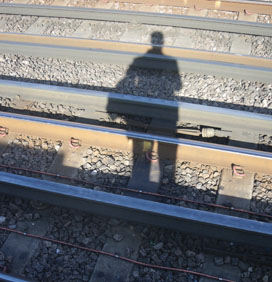As we featured in the December 2015 print issue of Professional Security magazine, suicide is a security issue – whether officers on patrol are able to intercept someone who looks like taking their own life, or often being the first to respond to an actual suicide. Suicide prevention is also a security, policing and ‘designing out crime’ issue, by applying situational crime prevention techniques, as the UK Security Expo 2017 heard at London Olympia, in a talk given by Katie Downs, crime reduction service delivery superviser at British Transport Police (BTP).
Why does suicide prevention, and work to reduce it, take up a fair chunk of BTP time? Because dealing with suicides takes up time and is distressing all round – to railway staff who have to manage the scene, and the disruption to trains. The 350 to 400 lives lost on the railways each year through people taking their own lives means £60m lost to the railway industry, as each minute of delay comes at a cost; as do ‘police deployment hours’, quite apart from the human tragedy.
Hence a variety of work to make it harder for people to take their own lives, or to trigger people into not committing suicide, whether through some physical barrier that makes it harder for someone wishing to commit suicide, or a member of staff intervening. At sites where someone does take their own life, police will attend and use CPTED (crime prevention through environmental design) methods to reduce the risk of it happening again. That could mean signgage to give the phone number for the Samaritans; or posters advertising the Samaritans’ service; or patrols or CCTV, or motion-activated voice messages; or help points or lighting; or ‘keep clear’ messaging and yellow lines at the platform edge. Fencing can block off unused platforms, and deny access to isolated parts of a station where someone may loiter, considering suicide.
As with CPTED in other scenarios, measures to tackle one issue may be helpful in another. Just as in public places bollards or street furniture can mitigate the risk of hostile vehicles – whether for a ram-raid robbery or for acts of terrorism – so anti-climb bars on bridges over railway lines can deter vandals, graffiti artists and trespassers in general, besides those considering suicide. Locked ladder plates likewise deny access to signal gantries, whatever the motive of people seeking to climb.
Samaritans campaign
Samaritans last month launched a campaign with British Transport Police, Network Rail and the wider rail industry to give travellers the confidence to trust their instincts and act if they notice someone who may be at risk of suicide in or around a station. There is no single sign or combination of behaviours that mean a person is suicidal but, if something doesn’t feel right, the message is to act, the charity says. Visit https://www.samaritans.org/news/small-talk-saves-lives-says-samaritans.
Samaritans CEO Ruth Sutherland said; ‘Suicide is everybody’s business and any one of us could have an opportunity to save a life. We have worked carefully with the public, rail travellers and those bereaved by suicide to ensure that this campaign is delivered sensitively but with real impact. The knowledge and skills to save lives in the rail environment can be applied to many other situations. We hope that Small Talk Saves Lives is the start of a much wider conversation about how suicide is preventable.”
See also the Network Rail website.










